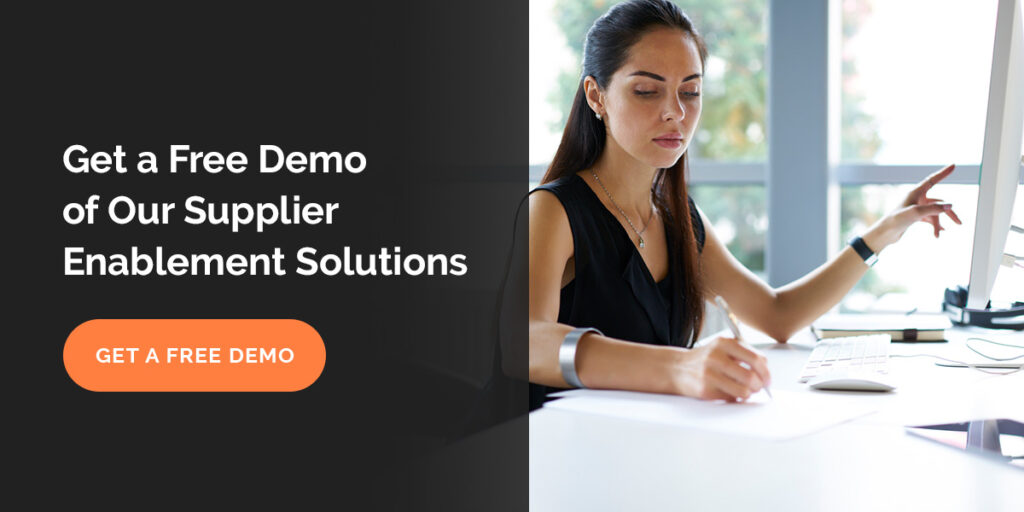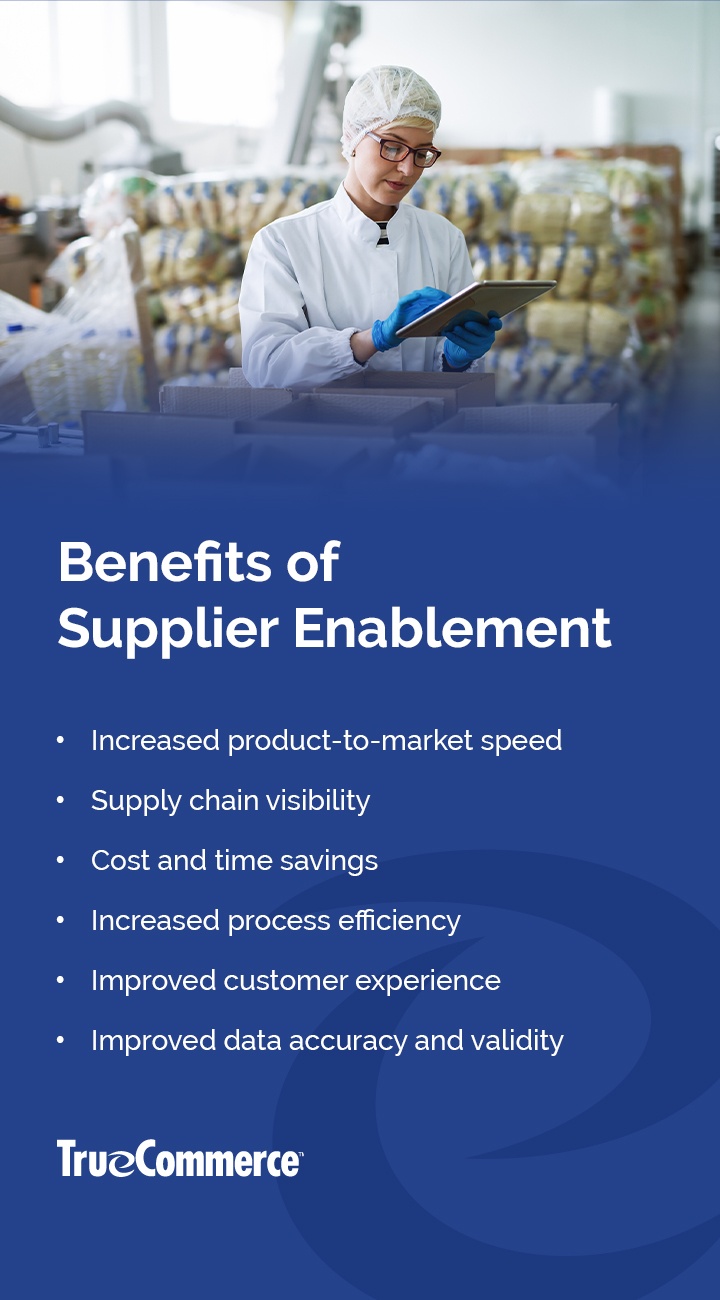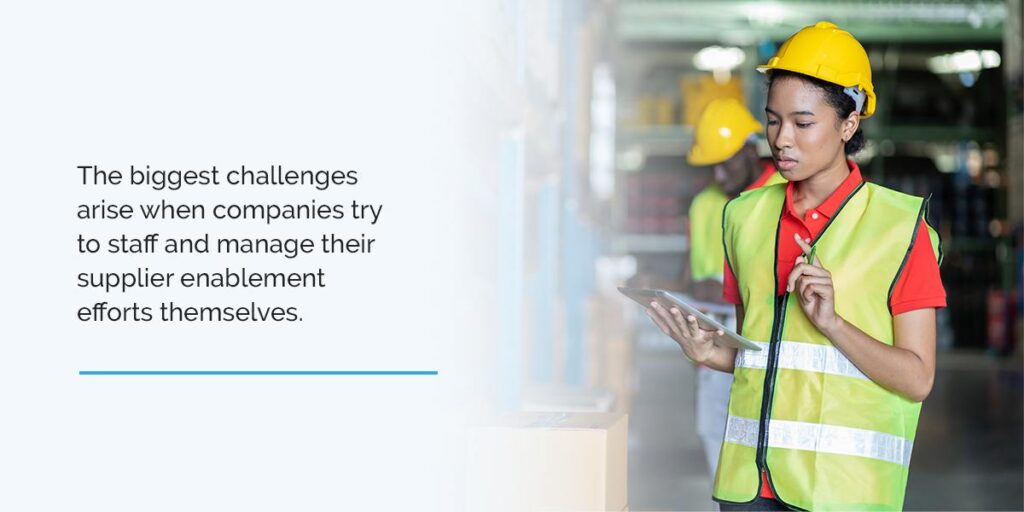Supplier Enablement Buyer’s Guide

Having suppliers scattered across the world — working different hours, speaking different languages and trading in different currencies — is common for many retail companies and organizations. While you share similar goals regarding serving your customers efficiently`, real-time collaboration may be challenging.
Technology-driven supplier enablement connects you and your suppliers via a portal to automate communication and transactions. Online collaboration can help improve business processes and communications across your supply chain and distribution centers.
Learn more about supplier enablement and how integrating it into your supply chain can benefit your company and suppliers.
What Is Supplier Enablement?
Supplier enablement offers retailers and manufacturers a standardized collaboration system to connect all their supplier relationships regardless of how the supplier runs their operation.
Retailers often work with numerous suppliers, each of which may have different technical capabilities, processes and methods of communication. It’s also common for suppliers to use different types of transactions. For example, one of your suppliers may use PDFs, another may use email, and another may use electronic data interchange (EDI).
Supplier enablement gives suppliers a choice regarding their connectivity options and makes processing the different transactions and communication methods easier for retailers and manufacturers. With a supplier enablement program, your company can reduce costs and improve communication with your suppliers.
How Does Supplier Enablement Work?
Supplier enablement connects to and integrates with your company’s office systems. In general terms, supplier enablement integrates technology to import multiple types of communication, standardize them for easy processing and then send the correct format back. This allows each party to view important business documents in the format they’re capable of processing.
Supplier enablement works on both your end as the retailer and on the supplier end. Understanding how the integration works on both ends is valuable, so here’s a closer look at supplier enablement for both the retailer and the supplier.
For the Retailer
On the retailer end, supplier enablement solutions automate the process of receiving essential documents like invoices, order acknowledgments and advance ship notices.
With this manual process now automated, document processing can be more dependable, and faster. Additionally, automation reduces errors and manual effort, further helping to complete core processes like fulfillment and procurement much more quickly.
The automation of supplier enablement programs can also reduce costs for your company and across the entire supplier chain. For example, suppliers with limited funds can save money by keeping their current transactional method rather than switching to the same method as your company and vice versa.
For the Supplier
Suppliers may use a range of document formats, ranging from a web portal or EDI to spreadsheets or PDFs. Supplier enablement offers flexible integration options so suppliers with different document formats can still connect to the program. Supplier enablement solutions allow seamless communication and document sharing between suppliers and their partners by automatically transforming data to fit their current systems. This feature connects all suppliers regardless of their technical capabilities, which incentivizes suppliers to adopt the program as well.
Similar to the retail side of things, technology-driven supplier enablement helps suppliers with process improvements and allows them to build stronger connections as they better serve their customers. For example, supplier enablement solutions can check that invoices match their retailers, saving time on manual labor that can result in human error. More accurate invoices can help improve company relations, building trust between suppliers and their clients.
Best Practices When Implementing a Supplier Enablement Program

Supplier enablement allows each party to view important business documents in a format they can process and can maximize the value of your supplier relationships when used successfully. Partnering with a managed service provider helps you determine the best way to use the integrated technology for your specific business. However, here are a few general best practices to keep in mind as you implement a supplier enablement program.
1. Focus on Key Strategic Suppliers
It can be challenging to determine where to start with supplier enablement. In most cases, you’ll want to start where you’ll make the most return on your investment. Look to the suppliers you use most often and that have a high volume of transactions. You likely have negotiated prices already in place, allowing you to get the most product for your money. As you bring in products from those key suppliers, you can offer them to customers right away.
Utilizing your relationships with key strategic suppliers allows you to be strategic about who you enable first. Focusing on your high-volume transaction suppliers shows them that you value your business relationship and helps you start benefitting from the supplier enablement system from day one.
2. Focus on a Subset of Suppliers
While starting big and enabling all your suppliers at once may sound like a good idea, it’s typically best to start small. Focus on a subset of your supplier list to ensure you are comfortable with the supplier enablement program before getting all your suppliers on board.
You’ll also have time to build and nurture stronger supplier relationships with that subset of vendors. Taking time to work on supplier relationships with your top suppliers will lead to more effective communication and a solid partnership. As a result, processes on both ends will be more streamlined and efficient.
3. Prioritize Consistent, Clean Delivery Addresses
When inputting delivery addresses in the supplier enablement system, be sure to keep them consistent and clean. Doing so will help save time and money on both the retailer and supplier ends. Suppliers can produce more accurate shipping labels, which improves billing and shipping mapping and reduces the chance of your products getting lost or becoming undeliverable.
On your end, clean addresses reduce the amount of time you have to spend manually checking addresses and intervening to correct errors. Consistency from the beginning is key to streamlining this part of order processing.
4. Build Your Integration Team
Integrating a supplier enablement program successfully takes the support of an entire team. With the right people helping you, you’ll be more likely to get your entire company on board with the new procedures. It’s best to create your team before starting the integration. Consider who you need to be involved with the process. Who will ensure engagement with suppliers, build trust and maintain communication?
Including these people early on in the integration process allows them to speak their minds and be an active part of improving your operations. It also allows everyone on your implementation team to learn how supplier enablement will work for your company so they can apply that knowledge in work and more effectively train other employees about the new processes if applicable.
Supplier Enablement Challenges

Despite being beneficial, supplier enablement solutions aren’t standard practice. Here are a few common challenges retailers and suppliers face when using supplier enablement:
- DIY supplier enablement program: Many companies try to manage a supplier enablement program on their own rather than partner with a managed services provider. In situations like this, organizations tend to lack the expertise required to manage their supplier enablement program themselves. Managing your own supplier enablement program may require you to hire an employee with proper knowledge or assign new responsibilities to existing employees, both of which require time and resources you may not have.
- Challenging implementation: Working with many suppliers and vendors can help get your products in new places. However, a diverse supply chain can also present problems when implementing supplier enablement. For example, onboarding vendors that lack EDI capabilities can make implementation an obstacle. With various vendors, your company could likely bring on many suppliers and then have to troubleshoot their setup and connections and otherwise continue supporting them. This will inevitably become draining for your company’s resources, which is why many companies avoid implementing a supplier enablement solution altogether.
- EDI mandates: Some companies require their suppliers to have EDI capabilities to ensure they can easily process all data through their setup. While this would allow you as the retailer to seamlessly import EDI transactions, EDI mandates tend to be demanding for less technically sophisticated suppliers. Suppliers with fewer technical capabilities would be required to get an EDI solution, which will cost them time, money and resources to implement and maintain.
- Not understanding the impact on the suppliers: It may go without saying, but any supplier enablement system a company implements will affect its suppliers. Understanding how the program will affect your suppliers is crucial, though many organizations forget to look beyond their internal operations. Learning how these changes to your systems will affect your suppliers’ processes can help you accommodate them as they adjust to your changes rather than creating barriers for them.

The biggest challenges arise when companies try to staff and manage their supplier enablement efforts themselves. The best way to solve these potential challenges is to work with a fully managed services provider like TrueCommerce. We handle various aspects of your supplier enablement program so you can focus on running your company.
From staffing and managing your program to supporting your supplier chain and integrating all systems, our managed services approach is cost-effective, reduces risk to your company and provides value quickly. Managed services providers will also configure your supplier enablement program to integrate with your existing business systems to ensure your unique needs are met.
Get a Free Demo of Our Supplier Enablement Solutions
Effective collaboration with your network of suppliers is crucial to the success of your partnerships and success as a company. Onboarding and compliance management of potentially thousands of suppliers remains a challenge. Supplier enablement managed services from TrueCommerce can help your company save time and money, gain supply chain visibility and streamline supplier enablement. We make it simple to ensure your suppliers are compliant.
TrueCommerce supplier enablement solutions connect your suppliers to EDI capabilities with an easy-to-use portal. We can even provide an optical character recognition (OCR) setup for suppliers who opt out of an EDI translator. Our cost-effective solutions provide the highest levels of collaboration and integration throughout your supplier network. Find out how TrueCommerce can manage your supplier network with a free demo today.
